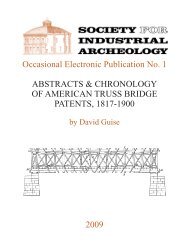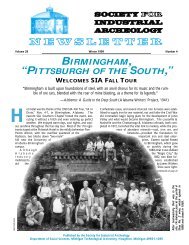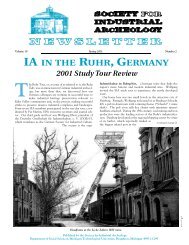SIAN - Society for Industrial Archeology
SIAN - Society for Industrial Archeology
SIAN - Society for Industrial Archeology
You also want an ePaper? Increase the reach of your titles
YUMPU automatically turns print PDFs into web optimized ePapers that Google loves.
equired the skill of many engineers willing to take risks and<br />
extend their engineering knowledge beyond established<br />
limits. Their <strong>for</strong>esight and intuition contributed to the<br />
refinement and advancement of design techniques <strong>for</strong> suspension<br />
and arch bridges.” The Bridges of Niagara are the<br />
Niagara Suspension Bridge (1848); Lewiston & Queenston<br />
Suspension Bridge (1851); Niagara Railway Suspension<br />
Bridge (1855); Niagara Falls & Clifton Suspension Bridge<br />
(1869); Niagara Cantilever Railway Bridge (1883); Niagara<br />
Railway (Whirlpool Rapids) Arch Bridge (1897)*; Falls<br />
View (Honeymoon) Arch Bridge (1898); Lewiston &<br />
Queenston Suspension Bridge (1899); Michigan Central<br />
Arch Bridge (1925)*; Rainbow Arch Bridge (1941)*; and<br />
the Lewiston-Queenston Arch Bridge (1962)*. (* currently<br />
in use.)<br />
Preserved ... Harrison Coal & Reclamation Historical<br />
Park (New Athens, OH) is preserving a c.1950 Marion<br />
7200 dragline donated by James Brothers Coal Co.<br />
Volunteers have been mobilizing to raise funds to move the<br />
dragline, which has a 7-yd. bucket, 120-ft. boom, and a<br />
Fairbanks-Morse engine. Up to 18 semi-truck loads (four of<br />
them oversize) will be required to move the disassembled<br />
dragline to the park <strong>for</strong> reassembly. The Marion 7200 will<br />
be joining the HCRP’s growing shovel and dragline collection<br />
that includes a Hanson 31 shovel, Marion 111-M<br />
dragline, and Insley L dragline. The park’s ultimate goal is<br />
to acquire the Silver Spade, a 105-cu.-yd. Bucyrus-Erie<br />
1950-B, the last operating stripping shovel in Ohio, and one<br />
of only four in the U.S. The organization is seeking volunteers<br />
and donations to help it preserve southern Ohio’s surface<br />
mining heritage. Info: www.hcrhp.org.<br />
New York City’s High Line project (<strong>SIAN</strong>, Spring-Summer<br />
2004) received a crucial federal authorization in June, effectively<br />
opening the way <strong>for</strong> the 1.5-mile-long viaduct’s trans<strong>for</strong>mation<br />
into a public park. The High Line was built<br />
between 1929 and 1934 to eliminate grade crossings of the<br />
New York Central’s West Side Freight Line in Manhattan.<br />
The last freight train operated in 1980 and since then the<br />
High Line had deteriorated. Since 1999, the Friends of the<br />
High Line (FHL) have been working to reuse the viaduct as<br />
an elevated walkway. Mayor Michael Bloomberg endorsed<br />
the project in 2002. The Surface Transportation Board<br />
(STB), the federal body that oversees rail corridors, issued a<br />
Certificate of Interim Trail Use (CITU) on June 13. The<br />
certificate enables CSX Transportation, the High Line’s<br />
current owner, to negotiate <strong>for</strong> the transferal of the High<br />
Line to the city. This process, known as “railbanking,” is a<br />
method of creating trails from out-of-use rail corridors. It<br />
was established by Congress in 1983. To date, over 13,000<br />
miles of rail-trails have been opened across the U.S., with<br />
nearly 16,000 more in development, but none that incorporate<br />
such a lengthy structure as the High Line.<br />
Threatened ... the Simon Silk Mills complex at 39th St. in<br />
Union City, NJ, is on Preservation New Jersey’s “10 Most<br />
Endangered Historic Sites” list. The mammoth industrial<br />
<strong>Society</strong> <strong>for</strong> <strong>Industrial</strong> <strong>Archeology</strong> Newsletter, Vol.34, No. 3, 2005<br />
site, many parts of which date to 1874, is the last of the<br />
great mills that made northern Hudson County a center of<br />
the silk textile industry. Info: www.nationaltrust.org/magazine/archives/arc_news_2005/021005.htm.<br />
Lost ... Four iconic smokestacks that were part of the Long<br />
Island City Powerhouse (1903-05) in Queens, New York<br />
City, have been demolished as part of a plan to redevelop<br />
what remains of the powerhouse as luxury condominiums.<br />
Roebling SIA chapter and other preservation groups initiated<br />
a campaign to save the 275-ft.-tall, black smokestacks<br />
but the developer was unwilling to wait to receive a variance<br />
that would have allowed them to be incorporated into<br />
the condo’s design. The powerhouse was one of the first<br />
steam-turbine generating plants in the country. For nearly<br />
a century it has been a prominent, visual landmark of the<br />
Queens waterfront.<br />
It has been over 100 years since the last iron lenticulartruss<br />
bridge was built. Now, a new bridge of this unique<br />
geometry has been fabricated and is currently on display at<br />
the University of Massachusetts—Amherst. Alan<br />
Lutenegger [SIA], Prof. of Civil & Environmental<br />
Engineering, designed the bridge; engineering students<br />
fabricated and constructed it. Modeled after the shortest<br />
spans built and sold by the Berlin Iron Bridge Co. of E.<br />
Berlin, CT, from about 1880 to 1900, the new bridge is a<br />
three-panel 20-ft.-long pony truss. It will be used as a<br />
pedestrian bridge. Like many of its predecessors, the new<br />
bridge has upper chords and end posts fabricated from<br />
channel sections, and lower chords composed of flat eye<br />
bars. Prof. Lutenegger is currently working on a book<br />
about the design and application of lenticular-truss bridges<br />
in the 19th century. He has visited all of the remaining 60<br />
or so built by Berlin and documented their dimensions and<br />
conditions. He is also planning to design and build a 5panel,<br />
40-ft.-long configuration next.<br />
23






